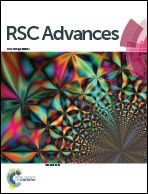Constructing one dimensional assembly of poly methylacrylic acid capping gold nanoparticles for selective and colorimetric detection of aminoglycoside antibiotics†
Abstract
Here, a self-assembly driven colorimetric method is described for detecting aminoglycoside antibiotics (AMGs) upon nanochain formation of poly methylacrylic acid capping gold nanoparticles (PMMA-@-Au NPs). After addition of streptomycin, the development of new plasmonic coupling absorption in the higher-wavelength region, companied with a prominent color change from wine red to blue, and TEM observation clearly reveal formation of a chain-like nanostructure of PMMA-@-Au NPs. The amine-groups on the AMGs can serve as a molecular bridge for electrostatic coupling with two carboxylic acids from adjacent particles to drive PMMA-@-Au NPs with chain-like arrays, where the molecular linkers are also target analytes. The selective detection can be achieved by the UV spectra of AMGs, including gentamicin, neomycin and kanamycin, with other types of antibiotics. Finally, the interference from metal ions competition can be eliminated by adding a strong metal ion chelator such as EDTA.


 Please wait while we load your content...
Please wait while we load your content...